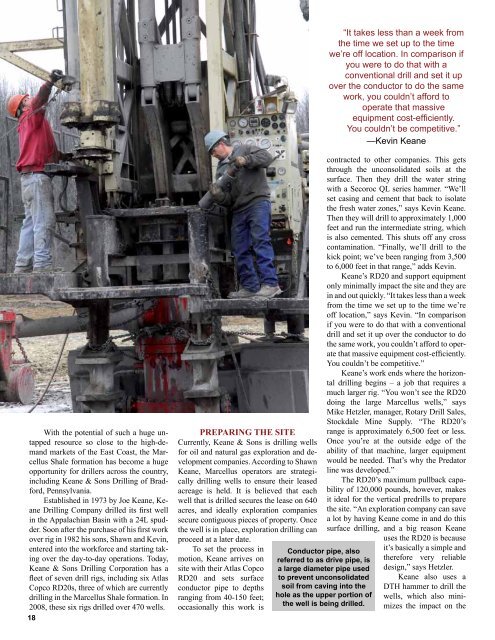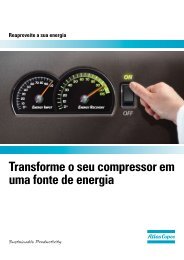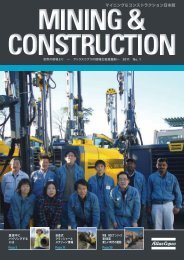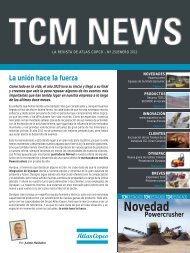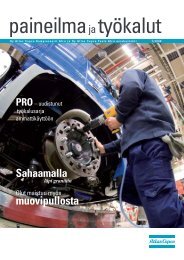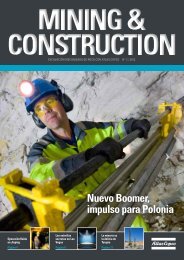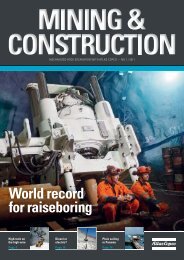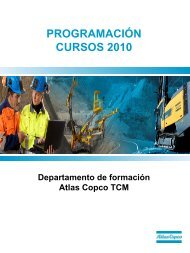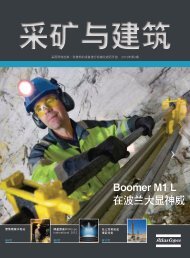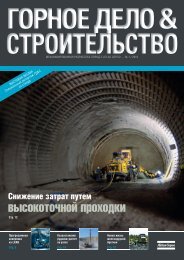atlas CopCo Center of exCellenCe sets itself apart for water well ...
atlas CopCo Center of exCellenCe sets itself apart for water well ...
atlas CopCo Center of exCellenCe sets itself apart for water well ...
Create successful ePaper yourself
Turn your PDF publications into a flip-book with our unique Google optimized e-Paper software.
With the potential <strong>of</strong> such a huge untapped<br />
resource so close to the high-demand<br />
markets <strong>of</strong> the East Coast, the Marcellus<br />
Shale <strong>for</strong>mation has become a huge<br />
opportunity <strong>for</strong> drillers across the country,<br />
including Keane & Sons Drilling <strong>of</strong> Brad<strong>for</strong>d,<br />
Pennsylvania.<br />
Established in 1973 by Joe Keane, Keane<br />
Drilling Company drilled its first <strong>well</strong><br />
in the Appalachian Basin with a 24L spudder.<br />
Soon after the purchase <strong>of</strong> his first work<br />
over rig in 1982 his sons, Shawn and Kevin,<br />
entered into the work<strong>for</strong>ce and starting taking<br />
over the day-to-day operations. Today,<br />
Keane & Sons Drilling Corporation has a<br />
fleet <strong>of</strong> seven drill rigs, including six Atlas<br />
Copco RD20s, three <strong>of</strong> which are currently<br />
drilling in the Marcellus Shale <strong>for</strong>mation. In<br />
2008, these six rigs drilled over 470 <strong>well</strong>s.<br />
18<br />
PreParing tHe site<br />
Currently, Keane & Sons is drilling <strong>well</strong>s<br />
<strong>for</strong> oil and natural gas exploration and development<br />
companies. According to Shawn<br />
Keane, Marcellus operators are strategically<br />
drilling <strong>well</strong>s to ensure their leased<br />
acreage is held. It is believed that each<br />
<strong>well</strong> that is drilled secures the lease on 640<br />
acres, and ideally exploration companies<br />
secure contiguous pieces <strong>of</strong> property. Once<br />
the <strong>well</strong> is in place, exploration drilling can<br />
proceed at a later date.<br />
To set the process in<br />
motion, Keane arrives on<br />
site with their Atlas Copco<br />
RD20 and <strong>sets</strong> surface<br />
conductor pipe to depths<br />
ranging from 40-150 feet;<br />
occasionally this work is<br />
Conductor pipe, also<br />
referred to as drive pipe, is<br />
a large diameter pipe used<br />
to prevent unconsolidated<br />
soil from caving into the<br />
hole as the upper portion <strong>of</strong><br />
the <strong>well</strong> is being drilled.<br />
“It takes less than a week from<br />
the time we set up to the time<br />
we’re <strong>of</strong>f location. In comparison if<br />
you were to do that with a<br />
conventional drill and set it up<br />
over the conductor to do the same<br />
work, you couldn’t af<strong>for</strong>d to<br />
operate that massive<br />
equipment cost-efficiently.<br />
You couldn’t be competitive.”<br />
—Kevin Keane<br />
contracted to other companies. This gets<br />
through the unconsolidated soils at the<br />
surface. Then they drill the <strong>water</strong> string<br />
with a Secoroc QL series hammer. “We’ll<br />
set casing and cement that back to isolate<br />
the fresh <strong>water</strong> zones,” says Kevin Keane.<br />
Then they will drill to approximately 1,000<br />
feet and run the intermediate string, which<br />
is also cemented. This shuts <strong>of</strong>f any cross<br />
contamination. “Finally, we’ll drill to the<br />
kick point; we’ve been ranging from 3,500<br />
to 6,000 feet in that range,” adds Kevin.<br />
Keane’s RD20 and support equipment<br />
only minimally impact the site and they are<br />
in and out quickly. “It takes less than a week<br />
from the time we set up to the time we’re<br />
<strong>of</strong>f location,” says Kevin. “In comparison<br />
if you were to do that with a conventional<br />
drill and set it up over the conductor to do<br />
the same work, you couldn’t af<strong>for</strong>d to operate<br />
that massive equipment cost-efficiently.<br />
You couldn’t be competitive.”<br />
Keane’s work ends where the horizontal<br />
drilling begins – a job that requires a<br />
much larger rig. “You won’t see the RD20<br />
doing the large Marcellus <strong>well</strong>s,” says<br />
Mike Hetzler, manager, Rotary Drill Sales,<br />
Stockdale Mine Supply. “The RD20’s<br />
range is approximately 6,500 feet or less.<br />
Once you’re at the outside edge <strong>of</strong> the<br />
ability <strong>of</strong> that machine, larger equipment<br />
would be needed. That’s why the Predator<br />
line was developed.”<br />
The RD20’s maximum pullback capability<br />
<strong>of</strong> 120,000 pounds, however, makes<br />
it ideal <strong>for</strong> the vertical predrills to prepare<br />
the site. “An exploration company can save<br />
a lot by having Keane come in and do this<br />
surface drilling, and a big reason Keane<br />
uses the RD20 is because<br />
it’s basically a simple and<br />
there<strong>for</strong>e very reliable<br />
design,” says Hetzler.<br />
Keane also uses a<br />
DTH hammer to drill the<br />
<strong>well</strong>s, which also minimizes<br />
the impact on the


